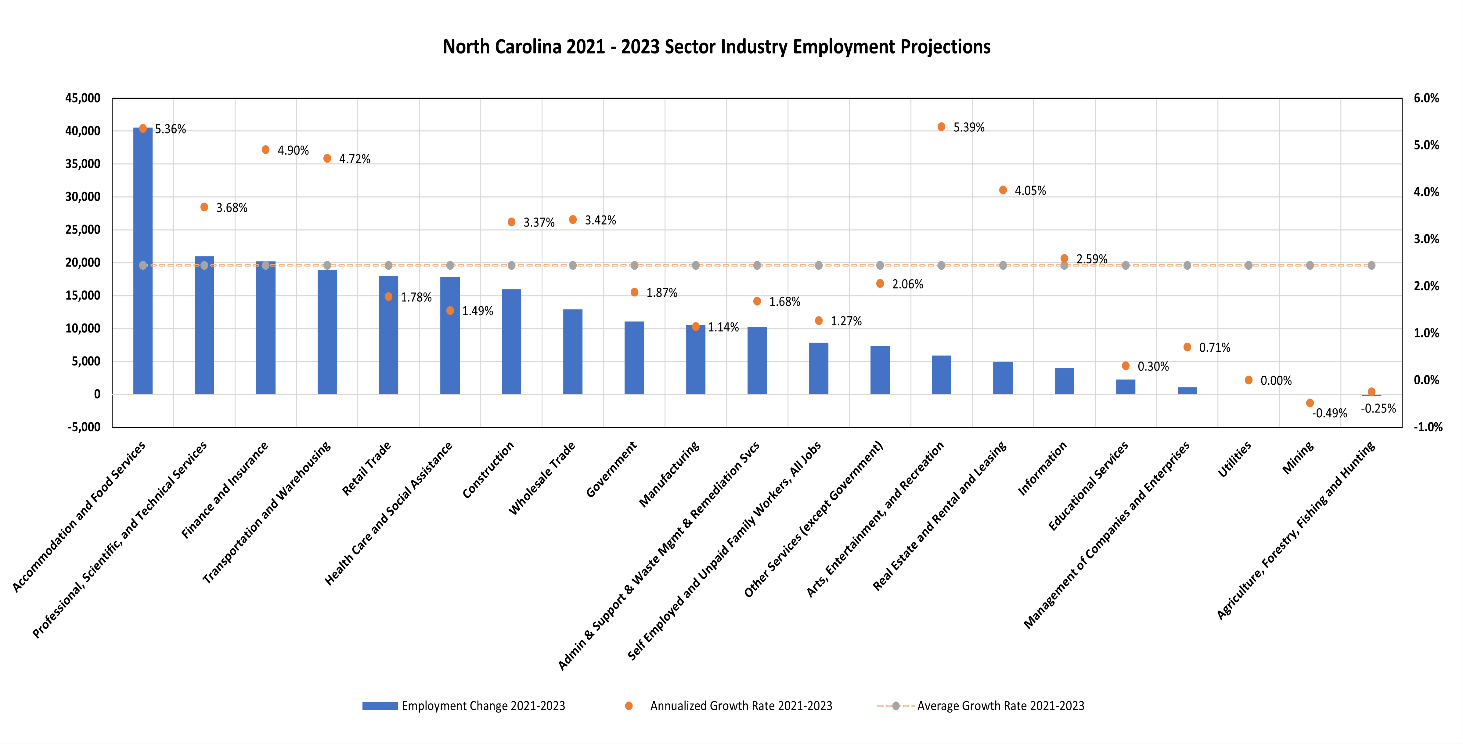Author: Negussie Asfaw
LEAD recently published the Short-Term Employment Projections for 2021-2023 at https://www.nccommerce.com/data-tools-reports/labor-market-data-tools/employment-projections. Short-Term Employment Projections are released in March every year. These 2-year statewide projections are based on analyses of the business cycle and historical and socioeconomic indicators. This differs from long-term projections, which assume a labor market in equilibrium and project employment 10 years out.

This analysis projects a continued growing economy, with an increase of 230,137 or 4.8% between the second quarter of 2021 (2021 Q2) and the first quarter of 2023 (2023 Q1). This is mostly driven by growth in service-providing industries (+196,056), but also growing goods-producing industries (+26,253). The service-providing industry sectors with the largest growth are projected to be:
- Accommodation and Food Services (+40,526), led by Food Services and Drinking Places (+31,946),
- Professional, Scientific, and Technical Services (+20,976),
- Finance and Insurance (+20,213), led by Credit Intermediation and Related Activities (+11,527),
- Transportation and Warehousing (+18,850), led by Warehousing and Storage (+14,433), and
- Retail Trade (+17,995), led by Building Material and Garden Equipment and Supplies Dealers (+3,482).
With the exception of Accommodation and Food Services, these projected changes put employment in these industry sectors above pre-pandemic (i.e. first quarter of 2020) levels.
The projections also include percentage changes, which can highlight smaller but growing industry sectors and industry subsectors. The service-providing industry sectors with the fastest projected growth differ somewhat from the ones with the largest growth over the two-year period:
- Arts, Entertainment, and Recreation (+11%) - led by Amusement, Gambling, and Recreation (+27%),
- Accommodation and Food Services (+11%) - led by Accommodation (+27%),
- Finance and Insurance (+10%) - led by Securities, Commodity Contracts, and Other Financial Investments and Related Activities (+13%),
- Transportation and Warehousing (+10%)- led by Warehousing and Storage (+27%), and
- Real Estate and Rental and Leasing (+8%) - led by Rental and Leasing Services (+12%).
Despite this growth, Arts, Entertainment and Recreation employment is still projected to be below its pre-pandemic level. Real Estate and Rental and Lending is projected to be slightly above its pre-pandemic level.
As for goods-producing industry sectors, Construction, which has already grown beyond its pre-pandemic level, is projected to have the largest increase in jobs and the largest projected growth, (+15,978/+7%), led by Specialty Trade Contractors (+9,034/+6%).
In addition to industry projections, occupation projections are available as part of this release. All occupation families are projected to grow over the two-year period. These increases reflect the continuing growth on NC’s economy.
The occupational families (major groups) that show the largest increases in projected employment are:
- Transportation and Material Moving Occupations (+33,459)
- Food Preparation and Serving Related Occupations (+33,427)
- Sales and Related Occupations (+20,496)
- Office and Administrative Support Occupations (+17,239)
- Business and Financial Operations Occupations (+16,374)
The occupational families that have the fastest projected growth rates are:
- Food Preparation and Serving Related Occupations (+9%)
- Personal Care and Service Occupations (+7%)
- Transportation and Material Moving Occupations (+7%)
- Computer and Mathematical Occupations (+7%)
- Arts, Design, Entertainment, Sports, and Media Occupations (+6%)
Finally, it may be useful to compare North Carolina’s projections to other states’. These can be accessed at https://projectionscentral.org/Projections/ShortTerm. Note that while the projections period is the same for all states, the data referenced may not be uniform in all cases. For example, North Carolina used 2021 Q1 data as a base and adjusted estimates using Quarterly Census of Employment and Wages (QCEW) and Current Employment Statistics (CES) data from 2021 Q2 and 2021 Q3. Some other states used only 2021 Q1 or Q2 QCEW data.
Disclaimer/Data Note:
The 2021-2023 Short Term Employment Projections were developed over a period from December 2021 - early March 2022. The projections method and assumptions were developed by the Bureau of Labor Statistics. These projections utilize a wide variety of models to determine short term industrial trends, which in turn impact the occupational projections.
Generally, these projections assume the following to be true over projected time period (2021-2023):
- Work patterns will not change significantly over the projections period (i.e., the average workweek will not change markedly)
- Broad social and educational trends will continue
- There will be no major war
- There will not be a significant change in the size of the Armed Forces
- Fluctuations in economic activity due to the business cycle will continue to occur
- There will be no major recession
